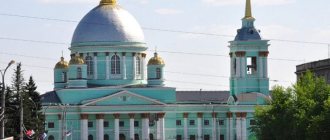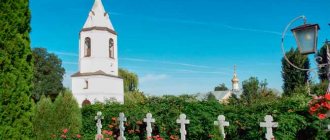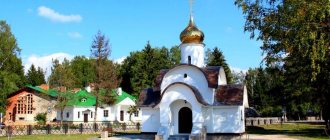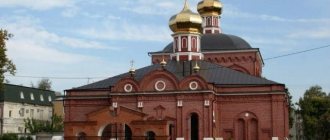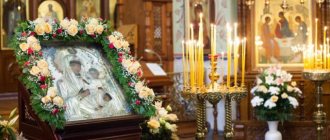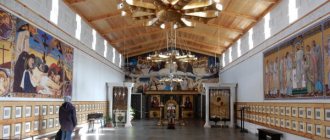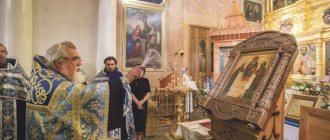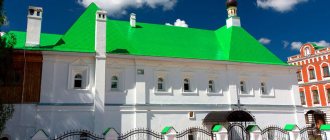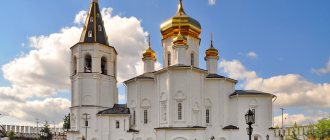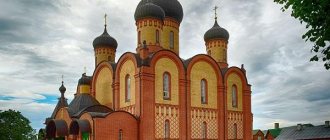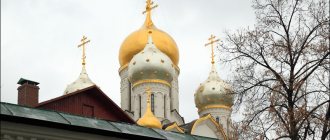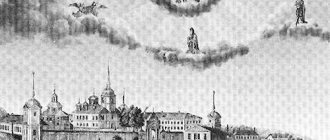Znamensky Monastery in Irkutsk (Russia) - description, history, location. Exact address and website. Tourist reviews, photos and videos.
- May tours
to Russia - Last minute tours
to Russia
1/
10
Znamensky Monastery in Irkutsk Verwit, Wikicommons
Znamensky Convent in Irkutsk is one of the largest and oldest in Siberia. Considering his location in a harsh region, it is easy to understand why, in addition to church functions, he also performed other, not the most highly spiritual ones. The monastery in Irkutsk is a notorious place of exile for the Decembrists and their relatives. Today the Znamensky Monastery is a place of pilgrimage and one of the main tourist attractions of the city, located at the confluence of the Ushakovka and the Angara. The silhouette of its turrets, made in the unique Siberian Baroque style, is perhaps the most recognizable view of Irkutsk.
History[edit]
St. Innokenty Irkutsk
The monastery was founded in 1689 on the right bank of the Angara. The first buildings were wooden, and by 1727, the Cathedral Church of the Sign, which was cut down in 1693, had fallen into disrepair. In 1762, the stone building of the monastery was rebuilt. The chapels and other objects were completed over several years.
On the night of February 6-7, 1920, the Supreme Ruler of Russia Alexander Kolchak and the Chairman of the Council of Ministers Viktor Pepelyaev were shot in the immediate vicinity of the monastery. With the arrival of Soviet power in Irkutsk, only the church building remains at the disposal of the local diocese, and the monastery is closed. Hydroaviation departments are located in religious premises: the Irkutsk hydroport has been located at the mouth of Ushakovka since 1928.
In 1926, the Znamensky Church became a parish church, and from 1929 it began to serve as a cathedral, since the Cathedral of the Epiphany was completely closed to religion, and the Kazan Cathedral was completely demolished. Seven years later, the Znamensky Church is closed again; its buildings house aircraft repair shops and garages.
With the beginning of the war, the Irkutsk hydroport stopped passenger transportation, pilots and aircraft were mobilized. The monastery only had NKPS seaplanes left, which served the BAM. The Znamenskaya Church was returned to the diocese in 1945. In 1948, its status as a cathedral was also returned. In 1953, the NKPS seaplane base was closed.
On August 30, 1960, by Decree of the Council of Ministers of the RSFSR No. 1327 (Appendix 1), the complex of the Znamensky Monastery was transferred to the rank of architectural monuments of republican (federal) significance and placed under state protection.
Since 1991, the relics of St. Innocent of Kulchitsky have again rested in the Znamenskaya Church, and on August 27, 1994, the rite of monastic tonsure was revived in the monastery. Currently, the diocesan administration of the Irkutsk Metropolis is located on the territory of the monastery.
Current state
In 1960, the monastery was placed under state protection as a historical and cultural monument. True, by this time not many buildings remained from it:
- Znamensky Church with three chapels, one of which, Preobrazhensky, is very dilapidated;
- holy gates;
- abbot's corps;
- monastery wall.
The building of the diocesan administration in the Znamensky Monastery
Currently, it is a functioning monastery, where the first tonsure was performed in 1994. The monastery is also the spiritual center of the Irkutsk diocese, since the Church of the Sign is a cathedral in which the ruling bishop often serves.
It all starts with prayer
The cell turned out to be a good, well-appointed hotel room, the only difference being that instead of primitive landscapes there were icons hanging on the walls. Contrary to assumptions, no one was puzzled by obedience; it probably meant a future report.
I slept well at night, either the long journey took its toll, or the place of worship made itself felt. At half past seven the next morning we moved towards the temple. On the way, a young man from the locals joined us and introduced himself as Vyacheslav. Within a minute he was telling in detail how the temple was being restored through their efforts. The monologue vaguely resembled a confession; it seemed to us that Vyacheslav was excited. The reason was found out later. It turned out that the drunken Slava was confused by a demon, and the two of them swore loudly, rowded, and now the man alone was in a hurry to atone for his sins.
Women in black clothes only at first glance seemed the same, but this is not so. We managed to note for ourselves that new nuns had appeared in the temple.
In the refectory
By eight o'clock the service ended, everyone moved towards the refectory. In the hallway/dressing room, I involuntarily noticed a separate hook for clothes and a small sign “For the Mother Superior.” There were five towels hanging in the bathroom, and short inscriptions explained who they were intended for - “for workers”, “for sisters”...
Contrary to expectations, the menu in the refectory turned out to be varied - several types of porridge, butter, boiled eggs, cottage cheese, sweets, cookies, two types of tea - black and green.
What to see
Today, the only surviving monastery buildings are the church, the holy gates, the abbot's cells and the fence. Opposite the main entrance, a building was recently erected to house the diocesan administration.
The architecture of the church is rooted in ancient Russian architecture, which is clearly expressed in the design features of the facade: double columns at the corners of the buildings, peculiar “curls” framing the windows. At the same time, the monastery has many elements of Siberian Baroque. Its features are the ornamental treatment of wall surfaces. The use of relief compositions consisting of simple figures (squares, triangles) gives the exterior a unique appearance.
Numerous pieces of decoration have also been preserved in the monastery: carved iconostases, images in ancient frames. Among the treasures of the monastery is “Savior Pantocrator”, dressed in a wonderful chased silver frame, made by local craftsmen in 1791.
In addition to the complex of monastery buildings, on the territory of the monastery there is an ancient cemetery where abbesses and nuns, as well as respected Irkutsk residents, were buried. In 1795, the founder of the Russian-American trading company, Grigory Shelikhov, was buried here.
Expansion of the monastery
In the 80s XVIII century The Kazan chapel was added to the main building of the cathedral. 7 years later Spaso-Preobrazhensky was added to it.
At the beginning of the 19th century, thanks to the financial assistance of local merchant N.S. Chupalova, the northern part of the monastery was increased by several stone cells with a built-in church, designated for hospital services. These buildings were consecrated by Bishop Mikhail of Irkutsk in 1818.
In the middle of the 19th century. With the charity funds of the local merchant E. Kuznetsov, the temple underwent significant reconstruction. After the completion of the repair work, it was given to the care of a women's religious school, built not far from the Znamensky Cathedral. In memory of the benefactor, the church was reconsecrated by Irkutsk Bishop Neil on January 16, 1854 in the name of St. Euthymius.
Activities of the parish
The Znamensky Monastery is not a parish in the literal sense of the word, but as one of the main monasteries of Irkutsk, it performs all the functions of the parish and is active in all spheres of life.
- The monastery provides spiritual care for the Irkutsk Orthodox Gymnasium.
- Volunteers visit an orphanage and boarding school.
- There is a Sunday school at the monastery.
A monument to Admiral Kolchak was erected on the territory of the monastery to commemorate the anniversary of his death and respect for the memory of the fallen white officers during the Civil War.
Shrines and landmarks
Despite the fact that the monastery was pretty much ravaged and destroyed, nevertheless, many artifacts and shrines have been preserved here.
- Elements of the old iconostasis.
- Gospel given by Peter I.
- Icon “Savior Pantocrator” in an original silver frame from 1791.
Graves of the Decembrists in the Znamensky Monastery
The preserved necropolis of the monastery is also unique. Here is the burial place of Grigory Shelikhov, the founder and head of the Russian-American trading company that developed Alaska and the western coast of North America. The Decembrists P. Mukhanov, N. Panova, exiled to Siberia, as well as the wives of the Decembrist Trubetskoy, Ekaterina Trubetskaya, were buried in the same cemetery.
Other temples in honor of the icon “The Sign”:
- Znamensky Cathedral in Tyumen
- Znamensky Church in Dubrovitsy, Podolsk
But the main shrines of the monastery are the holy relics of the Irkutsk bishops, glorified by the Church.
- Saint Innocent (Kulchitsky, 1680 - 1731). The first independent bishop of Irkutsk and Nerchinsk. Ordained bishop in 1727, he did a lot for Orthodoxy in the region and the education of the common people, although he ruled for a short time. After his death at the end of the 18th century, his remains were found incorrupt. And he was glorified in 1804. Since 1990, the relics have been in the Znamensky Church.
- Particle of St. relics of St. Sophrony (Kristalevsky), the third bishop of Irkutsk, ruling from 1753 until his death in 1771. His body remained unburied for 6 months, and there were no signs of decay. The saint's tomb burned down in 1917, all that remained was placed in a small reliquary, one of which is located in the Znamensky Monastery. The saint was glorified in 1918.
Important!
In the monastery cemetery there is the burial of the second Bishop of Irkutsk, Innocent II (Nerunovich), who ruled the diocese from 1732 to 1747 and was especially distinguished by his missionary activities among the pagan peoples of Siberia. In the monastery, near the southern wall of the temple, there is the grave of Valentin Rasputin, the great Russian and Soviet writer who died in 2015.
Work nowadays
In the pre-revolutionary period, for many years, the following people worked within the walls of the monastery:
- hospital;
- a shelter for preschool girls;
- parochial school;
- a home for the mentally ill;
- prosphora bakery;
- candle factory;
- greenhouse;
- handicraft room;
- bindery.
These institutions were served by 120 sisters who lived at the monastery. The most difficult work in the temple and its surroundings was performed by excommunicated women (“epithimians”). The walls of the cathedral also often became a haven for so-called state criminals from the great Russian cities of St. Petersburg and Moscow.
By the end of the 19th century. The Znamensky Convent was a fairly large economic complex. The handicraft workshop was of particular value in his activities. In it, skilled seamstresses made ceremonial clothes for priests, vestments for images, shrouds and many items of church decoration.
The townspeople also turned to the monastery needlewomen with requests to sew a beautiful lady's or wedding dress or shoes. The craftswomen mastered the artistic stitching of blankets to perfection.
Several sewing techniques were common among nuns:
- facial;
- gold embroidery;
- white and colored satin stitch embroidery;
- inlaid with beads and precious stones.
The gold embroidery workshop, where skilled craftswomen worked tirelessly, brought enormous fame to the Znamensky Monastery. Among them was the daughter of a noble statesman at that time, Artemy Volynsky, who was forcibly forced to take monastic vows. He was executed by the current ruler Anna Ioannovna.
Elizabeth, who replaced her in power, canceled the forced tonsure of Anna Volynskaya and returned her subject to St. Petersburg. In gratitude for the care of the sisters in the temple, Anna was given the altar gospel. Framed in a chased frame, it is one of the significant relics of the cathedral.
Towards the end of the 19th century. A school for girls was established within the walls of the cathedral. They were taught reading, church singing, literacy, and writing. At the beginning of the 20th century. it acquired the status of a parish church. At the same time, 44 girls were supported in the existing shelter at the temple.
In modern times, the temple is not an official parish, but fully carries out all its functions. He is the spiritual patron of the Irkutsk Orthodox Gymnasium. The sisters living there visit the boarding school and orphanage as volunteers. On Sundays there is a school within the walls of the cathedral.
Contract with God
Permission or accreditation for filming and communication in the monastery replaces the blessing of the abbess.
– Mother Nika, how did the locals react to your arrival? I heard terrible things that the first nuns were almost kicked out, is that true? “Already when I was there, locals broke out windows, and 20 years ago, when the sisters were just settled here, terrible things happened - drunks burst in, cursed, broke windows... They even hit my older sister, Mother Evnikia, and she walked around with a bruise. The men shouted: “Why did you come here? What would you like? Go away!
The village at that time was completely degraded and was in a dope. In addition to low-quality alcohol, consumption of hemp, which grows around, resulted in people simply not realizing what they were doing. We watched many times how fellow villagers beat each other, and simply killed. Here, Slava, is one of the typical representatives. Why do you think he is walking and crying now? Because two or three days ago he wandered around the village, shouting obscenities, and his brothers periodically become enraged after drinking alcohol. But now these are isolated cases. Several times a year we make a religious procession with shrines, and I think this helps, the village is slowly coming to life. When I came here, there was only one girl growing up in the village, unfortunately, not so long ago she died in a road accident. And now people have come to Baturino, several houses have been built and six children are already going to school.
Mother Nika during the procession
– What year did you arrive? – In 2009. – Is leading a monastery such obedience? – I was in another monastery, I didn’t want to come here, but they told me: “You made a vow - to serve God in the capacity in which he sees you. Go and do your obedience.” – What stopped you? – The monastery was in a difficult situation, six sisters lived here, there were almost no parishioners, few people were interested in the development of Orthodoxy, and there was nowhere to wait for help. But since she was a nun, she went to do what she was assigned. - Mother Nika, who were you in the world? – It’s easier to say, an accountant-economist. At 43, I entered a monastery while on disability. It so happened that oncology was added to the diseased heart, they could not operate on me - the anesthesiologists refused to work. My son was then studying at the Faculty of Medicine in Cheboksary, and told me: “Write a receipt. You are a believer, the Lord knows that your son and daughter need you first of all, and it will be as it will be.” The choice was this: to die quietly from cancer, or right away on the table. All is in God's hands. It was 2002. Immediately before the operation, I mentally made an agreement with God: if I stay alive, I will go to a monastery and serve in the capacity in which the Lord sees me. The operation was successful, and two weeks later, after the stitches were removed, I went to the monastery. I understand that every person is a lie, and I first of all. When I woke up from anesthesia, I remembered what I promised and asked myself the question: “What did you promise? What did you do? – It turns out that you were afraid of your own words? - Yes. But my parents raised me this way: if you promised, then break, but do it. And then I promised it to whom – God! I was very afraid to tell my children about this. She told her son first; he was already married and they had a girl. And he supported me. And the daughter is the opposite: “Who will help Lyosha? Then you’ll leave!” I tell her: “They don’t play hide and seek with God, I already promised.” - “You will fulfill your promise, but later.” “It doesn’t happen later,” I answer. So she left.
– Excuse me, but what does care look like at the everyday level? You have a family - a son, a daughter. How to give up everything worldly and leave them there? “My son couldn’t tear himself away from me for a very long time. Even when I was sent to Baturino, he moved his family here, and now they have gone back to Cheboksary. Everything did not happen at once. No. They came to the monastery and worked. I don't know about others. Now my daughter lives in St. Petersburg, there are no children yet, but my son has four growing up. You know, we are very friendly. – Are the sisters also sent or do they choose the monastery themselves? – They choose for themselves. They come, take a closer look, try and then decide for themselves whether to stay or not. – Is there any kind of probationary period? - Necessarily. I usually suggest: “Come, live for a year. We'll look at you, you look at us. There we’ll see if we can accept you into our family.” – What could be an obstacle to admission? – There are people who are not monastic at all. Why does a person come to a monastery? To fix your life. It happens that a person begins to teach everyone, but he himself does not want to learn anything. Everything is wrong for him. Complains to the abbess about one, another, a third. Poorly performs obediences. Then you have to ask: “You go to your home, we are not suitable for you.” Mental illness may be an obstacle. Every year, 10-15 people come with schizophrenia, they think they can do it here. Sometimes you get obsessed with ideas, you don’t even sleep, and this is dangerous.
Mother Anastasia
— Can a person himself refuse during the probationary period? - Certainly. We cannot force anyone, everything is voluntary. Especially before tonsure. He lives for a year and says: “I decided to stay.” After that I say: “Let's pray together. Let’s see whether the Mother of God will give you her clothes or not.” Here such passions come out in a person, crying: “Why can’t I cope with myself?” This is in the world, if something goes wrong at work, you turn around and go home, or quit and choose another team. And here every day there are only faces - in the refectory, in the house, during obedience. Husband and wife do not always stand each other. And then there’s the women’s team... – Even in a monastery?! – Of course, but there are solutions for everything. Why do we have so much work? When we women get tired, we become kind and soft. And so we will direct the unspent energy against each other. Here we work, get tired, sleep well, eat with appetite and don’t eat each other. – Yesterday you said things that were completely unexpected for me, for example, there is no commandment that you did not violate. Sorry, but I want to return to this topic. How is this possible? - Name any commandment, and I will prove that I violated it. - Let's say idolatry. “You can’t imagine how much I love flowers.” I talk as if they were alive, I love, I adore - this is idolatry. You cannot attach your heart to anything, only to God. Everything else is as God wills. - OK then. Why don't you kill? – If you wish something bad for a person with anger, in your hearts, you are already killing him. After all, a word can cure, a word can kill. And I doubted God, and had little faith...
Planning the monastic economy
– Having started obedience as an abbess of a monastery, what problem did you most often encounter first and foremost at the everyday level? – Misunderstanding at all levels. In one of the first winters we literally froze because there was no coal. I went to ask the authorities, and not just like that, but as a loan. They refused me, saying that the church is separated from the state. What to do? I came, prayed, the decision was ripe. Many people think that we have nothing to do here, we come to the refectory to have everything ready - we sat down, ate, and went on to pray. But we don’t have a self-assembled tablecloth, so we need to get up early in the morning, pray, cook, clean, wash. And also feed the cows, milk them, weed the garden, pray again, wash the temple. They don’t sell clothes like this anywhere, we sew them ourselves to maintain our cells. We have little money, we have to earn money all the time. For example, in the summer we prepare fireweed (fireweed tea), ferment it until it has a berry aroma, then dry green or black tea. We harvest medicinal herbs and maintain an apiary. We have a large vegetable garden, a year-round greenhouse, and even in winter we eat fresh herbs. We prepare various pickles and jams, then go and see our vegetable storage. We have strawberry and raspberry plantations. But our sisters are both 84 and over 78 years old, and they all work, obey, and support each other. Yes, no one ever wanders around idly.
Work on the monastery plot
In general, I have a secular diploma in “National Economic Planning,” but I didn’t need it in the world, I worked as an accountant, and here the knowledge was useful. The monastery cannot be compared with any organization, because here I am not the actor, but the Lord. It was He who gave me the means, opportunities, knowledge and strength. We are a legal entity, we have the right to hire sisters who have not retired due to age, they are considered employees, we pay taxes, a full social package and we receive pensions. We put them in a pile and maintain the monastery. – Legally, the monastery is an individual entrepreneur? - No. Non-profit organization. – The monastery has a website. I know that confessions have different attitudes towards pages on the Internet, sometimes diametrically opposed. – Now the age is incredibly informative, people receive any information instantly. If we close down completely, what will happen then? Well, okay, I will save myself without allowing anyone else to save me nearby. I won’t tell anyone how you can change your life. The time will come when I will appear before God, and he will ask: “I gave you several talents, but where did you put them? Well, I built, decorated, but why didn’t I talk to people? People could find out and come to something through you.” Therefore, we provide the information that we can give. And my health is getting better and better and better. – Are nuns prohibited from accessing the Internet? Where is the line that cannot be crossed? “It’s like learning to use a sharp knife.” So that it does not become an instrument of torture, murder, etc. There is so much good on the Internet, but also a lot of dirt. You see, the devil does not invent anything new, he perverts everything that the Lord gives. It's not true that the devil invented the telephone, no. He didn't invent anything. The devil only perverts. I trust my sisters. If I don't do it, then why should I think that they do it? We take a vow of chastity, and this is not only the physical side, but also the spiritual, heart, and soul.
